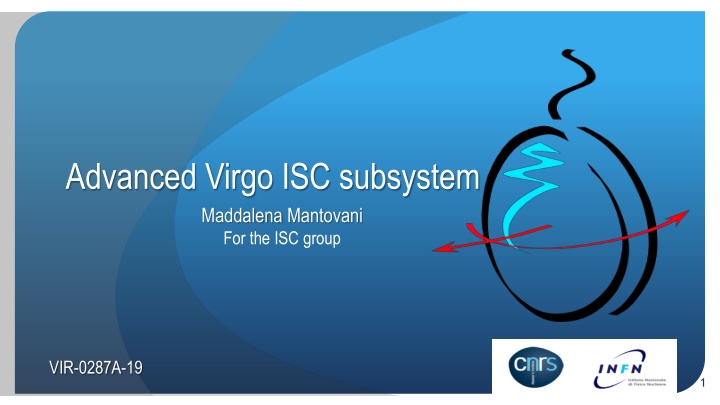
Advanced Virgo ISC Subsystem Control System Details
Discover the intricacies of the Advanced Virgo ISC subsystem, where precision control of main mirrors is essential for optimal detector sensitivity. Learn about the sophisticated control system developed to ensure proper alignment and functionality, as explained by Maddalena Mantovani during Virgo Week. Explore topics such as longitudinal degrees of freedom, angular control techniques, and the process of lock acquisition for steady state operation.
Download Presentation

Please find below an Image/Link to download the presentation.
The content on the website is provided AS IS for your information and personal use only. It may not be sold, licensed, or shared on other websites without obtaining consent from the author. If you encounter any issues during the download, it is possible that the publisher has removed the file from their server.
You are allowed to download the files provided on this website for personal or commercial use, subject to the condition that they are used lawfully. All files are the property of their respective owners.
The content on the website is provided AS IS for your information and personal use only. It may not be sold, licensed, or shared on other websites without obtaining consent from the author.
E N D
Presentation Transcript
Advanced Virgo ISC subsystem Maddalena Mantovani For the ISC group VIR-0287A-19 1
Introduction ISC The Advanced Virgo detector show its best sensitivity only when the main mirrors (PR,BS,NI,NE,WI,WE) are in precise microscopic positions (so called working point) Arm cavities on resonance Central destructive interference Power recycling resonance Mirrors aligned with respect the main beam interferometer on cavity on For this reason a very sofisticated control system has been developed and implemented 2 Maddalena Mantovani Virgo Week - ISC - Jan 22th 2019
Dofs to be controlled ISC Longitudinal degrees of freedom 3 Maddalena Mantovani Virgo Week - ISC - Jan 22th 2019
Dofs to be controlled ISC Arm cavities modes: Common(+) and Common(-) Differential(+) and Differential(-) PR BS The accuracy requirements are ~nrad for the cavity mirrors!!! Angular degrees of freedom 4 Maddalena Mantovani Virgo Week - ISC - Jan 22th 2019
Control principle ISC The mirrors are controlled by using the signals coming from the main beams, with a technique which is based on the modulation/demodulation technique (Pound-Drever-All technique). Phase modulation: create sidebands around the carrier ( 0) at the modulation frequency, . Error signal beat note between carrier and non- resonant sidebands Similar technique for the angular control 5 Maddalena Mantovani Virgo Week - ISC - Jan 22th 2019
Lock acquisition and steady state ISC The ISC subsystem take cares of bringing all the mirrors from un- controlled state to the final working point (which is called lock acquisition) and to maintain the final working with good performance, i.e. low noise and high duty cycle (steady state = science configuration). The lock acquisition has been developed as the adiabatic transition from steady states going towards more and more complex configurations 6 Maddalena Mantovani Virgo Week - ISC - Jan 22th 2019
Lock acquisition ISC Variable-finesse technique Steady state Lock aquisition 7 Maddalena Mantovani Virgo Week - ISC - Jan 22th 2019
Steady state performance ISC The duty cycle ensured by the ISC subsystem is usally larger than 80% 8 Maddalena Mantovani Virgo Week - ISC - Jan 22th 2019
ISC the end 9 Virgo Week - ISC - Jan 22th 2019




